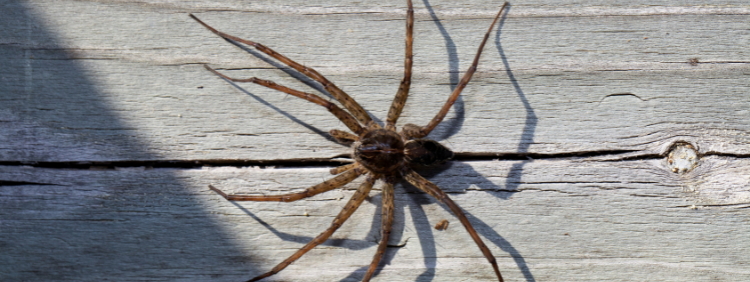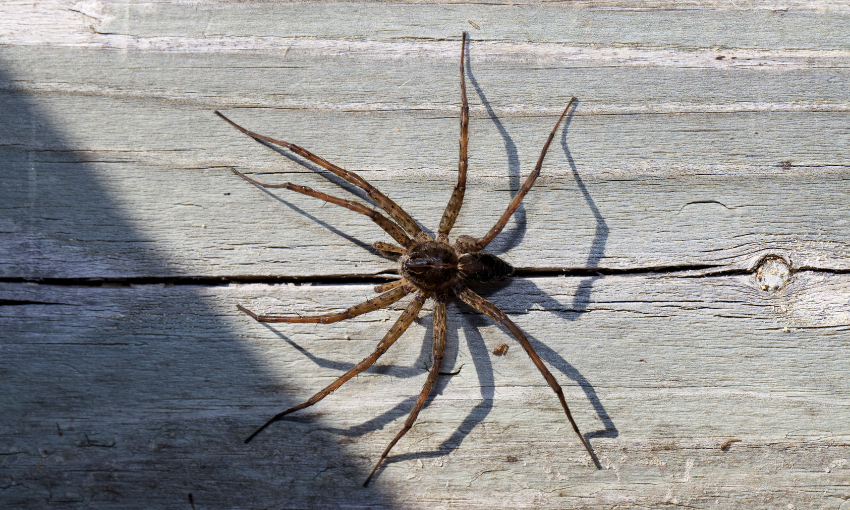
It is not typical to call for spider removal over dock spiders in homes as they are not common household pests. Dock spiders live near bodies of water, so it is more common to find them in places like boathouses and summer cottages. Also called fishing spiders or wharf spiders, they are the largest native spider species in Canada, and their size along with their resemblance to the wolf spider can be alarming. Nevertheless, dock spiders have some very admirable capabilities.
How Large Are Dock Spiders?
Female dock spiders are about twice the size of male dock spiders. The body of a female can range from 15 to 26 millimetres in length. When you factor in the length of the legs, a female dock spider can reach the size of the hand of an adult.
How Can You Tell Dock Spiders Apart From Wolf Spiders?
The wolf spider is another large Canadian species, though the dock spider tends to be the larger of the two. The two do look very similar to one another. Wolf spiders may be found on beaches and in marshes and ponds, though they tend to prefer meadows, fields, and gardens.
One way to tell dock spiders apart from wolf spiders is to look at their eyes. Wolf spiders have three rows of eyes, while dock spiders only have two.
How Do Dock Spiders Catch Food?
Dock spiders feed on water insects, tadpoles, minnows, and frogs. They are capable of catching and eating prey five times larger than themselves and are one of the few spider species that can feed on vertebrates, albeit relatively small ones. A dock spider that is hunting for food rests its front legs on the water while dangling over the surface. When the dock spider’s prey disturbs the surface of the water, the spider feels the vibrations. The spider then catches the prey by literally running across the surface of the water to attack. Not many animals can walk on water, but the dock spider can manage because it has hairs that repel water and widely spaced legs that distribute its weight evenly to avoid breaking the surface tension.
Are Dock Spider Bites Dangerous?
A dock spider does have venom that it uses to immobilize and kill its prey. Dock spiders are not particularly aggressive toward humans, but they may bite defensively if they feel threatened. The bite of a dock spider is comparable to a bee sting and causes no long-term adverse effects.
Do Dock Spiders Spin Webs?
Dock spiders don’t catch prey in webs but they do use webbing to dangle above the water when hunting. Otherwise, the webs they spin are intended to protect their young rather than to catch food. The egg sac of a dock spider contains approximately 1,000 eggs. When the spiderlings hatch, the web the female spider spins shelters them until they mature. For this reason, dock spiders are sometimes also known as nursery-web spiders.
How Can You Deter Dock Spiders From Your Property?
If you own property by the shore, whether a summer cottage or a year-round home, there are things you can do to keep dock spiders away. Dock spiders need water in which to hunt, so if possible, you should remove any standing water from your property, or at least keep it to a minimum. Dock spiders also need places to build webs to protect their spiderlings, so you should keep grass and shoreline plants cut short and remove woodpiles, rocks, or other debris.
For Spider Removal, Rely on Truly Nolen
Though dock spiders are harmless, their presence could spoil your time at your summer cottage. Truly Nolen offers comprehensive pest control in Waterloo. Learn more about the services we offer.
